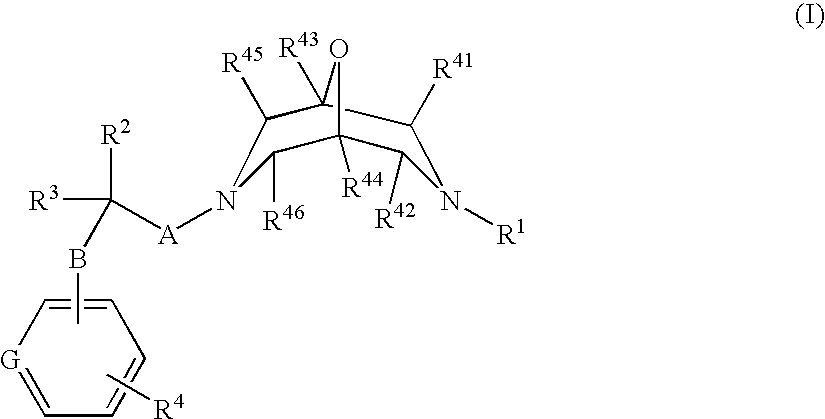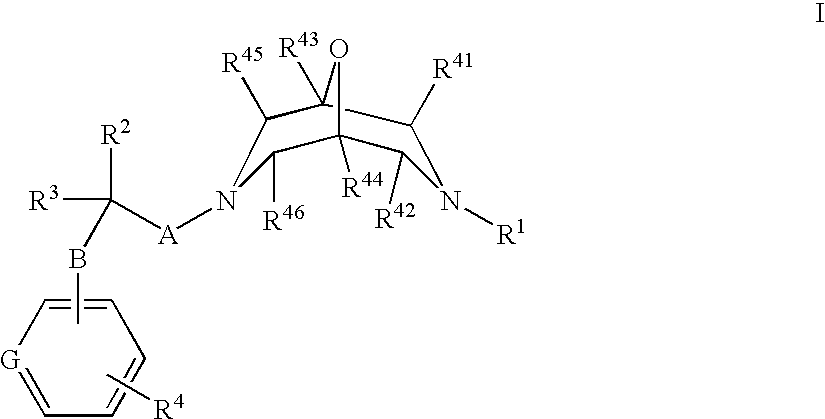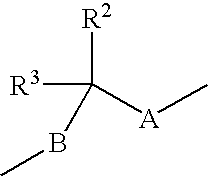Novel Oxabispidine Compounds And Their Use In The Treatment Of Cardiac Arrhythmias
a technology of oxabispidine and compounds, which is applied in the field of new oxabispidine compounds and their use in the treatment of cardiac arrhythmias, can solve problems such as (turning points)
- Summary
- Abstract
- Description
- Claims
- Application Information
AI Technical Summary
Benefits of technology
Problems solved by technology
Method used
Image
Examples
preparation d
1-[3-(9-Oxa-3,7-diazabicyclo[3.3.1]non-3-yl)propanoyl]indoline-5-carbonitrile, hydrochloride salt
(i) 5-Bromo-2,3-dihydro-1H-indole
[0323]NaBH3CN (19.3 g, 0.3061 mol) was added in 3 portions to a cooled (15° C.) solution of 5-bromoindole (20 g, 0.10 mol) in glacial acetic acid (500 mL) and stirred for 2 h at this same temperature. The reaction mixture was quenched with water, cooled and basified with a sodium hydroxide pellet. It was then extracted with diethyl ether. The organic layer was washed with water and brine, dried over sodium sulfate, concentrated and purified by column chromatography over silica gel to give the sub-title compound as a pale yellow solid. Yield: 20 g.
(ii) 5-Bromo-1-(trifluoroacetyl)indoline
[0324]5-Bromo-2,3-dihydro-1H-indole (20 g, 0.1010 mol; see step (i) above) was taken in (100 mL) of DCM and cooled to 0° C. Trifluoroacetic anhydride (42.42 g, 0.2020 mol) was added dropwise to the reaction mixture, which was then stirred for 30 min. The reaction mixture wa...
preparation b
4-Cyano-N-[2-(9-oxa-3,7-diazabicyclo[3.3.1]non-3-yl)ethyl]benzene-sulfonamide
(i) N-(2-Bromoethyl)-4-cyanobenzenesulfonamide
[0330]To an ice cooled solution of 2-bromoethylamine hydrogenbromide (12.2 g, 0.0595 mol) in dry dichloromethane (100 mL) was added triethylamine and the mixture stirred for 15 min. 4-Cyanobenzenesulfonyl chloride (10 g, 0.0486 mol) in dichloromethane was added, dropwise. Stirring was continued at RT for 1 h. The reaction mixture was diluted with dichloromethane, washed with water, followed by brine, then dried over sodium sulfate. Solvents were evaporated and the residue crystallized from petroleum ether to give 12.5 g of the sub-title compound as a pale yellow solid.
(ii) 7-[2-(4-Cyanobenzenesulfonylamino)ethyl]-9-oxa-3,7-diazabicyclo-[3.3.1]nonane-3-carboxylic acid tert-butyl ester
[0331]A suspension of N-(2-bromoethyl)-4-cyanobenzenesulfonamide (5 g, 0.017 mol; see step (i) above), 9-oxa-3,7-diaza-bicyclo[3.3.1]nonane-3-carboxylic acid tert-butyl ester (3.96 g...
example 1
N-(2-{7-[(2S)-3-(4-Cyanophenoxy)-2-hydroxypropyl]-9-oxa-3,7-diaza-bicyclo[3.3.1]non-3-yl}ethyl)-1-phenylmethanesulfonamide
[0426]4-{(2S)-3-[7-(2-Aminoethyl)-9-oxa-3,7-diazabicyclo[3.3.1]non-3-yl]-2-hydroxypropoxy}benzonitrile (0.096 g, 0.28 mmol; see step Preparation A above) was dissolved in a 1:2 ratio of DCM:acetonitrile (3 mL). Triethylamine (0.17 g, 1.68 mmol) was added, followed by phenylmethanesulfonyl chloride (0.068 g, 0.36 mmol). The mixture was stirred at room temperature overnight with K2CO3 (0.38 g, 2.77 mmol) to ensure that the free base of triethylamine was in the reaction mixture. The reaction mixture was filtered and the filtrate concentrated under reduced pressure. Purification by preparative HPLC gave 0.1 g (72%) of the title compound.
[0427]1H NMR (400 MHz, CD3OD) δ 7.64-7.66 (2H, d), 7.36-7.43 (5H, m), 7.05-7.07 (2H, m), 4.41 (3H, m), 4.17 (2H, m), 4.08 (2H, m), 3.62-3.7 (2H, m), 3.12-3.4 (8H, m), 2.72-2.86 (2H, m), 2.46-2.59 (2H, m).
PUM
| Property | Measurement | Unit |
|---|---|---|
| conduction velocity | aaaaa | aaaaa |
| action potential duration | aaaaa | aaaaa |
| chemical curiosities | aaaaa | aaaaa |
Abstract
Description
Claims
Application Information
 Login to View More
Login to View More - R&D
- Intellectual Property
- Life Sciences
- Materials
- Tech Scout
- Unparalleled Data Quality
- Higher Quality Content
- 60% Fewer Hallucinations
Browse by: Latest US Patents, China's latest patents, Technical Efficacy Thesaurus, Application Domain, Technology Topic, Popular Technical Reports.
© 2025 PatSnap. All rights reserved.Legal|Privacy policy|Modern Slavery Act Transparency Statement|Sitemap|About US| Contact US: help@patsnap.com



